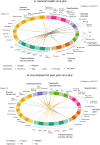Application of the urban exposome framework using drinking water and quality of life indicators: a proof-of-concept study in Limassol, Cyprus
- PMID: 31179170
- PMCID: PMC6536114
- DOI: 10.7717/peerj.6851
Application of the urban exposome framework using drinking water and quality of life indicators: a proof-of-concept study in Limassol, Cyprus
Abstract
Background: Cities face rapid changes leading to increasing inequalities and emerging public health issues that require cost-effective interventions. The urban exposome concept refers to the continuous monitoring of urban environmental and health indicators using the city and smaller intra-city areas as measurement units in an interdisciplinary approach that combines qualitative and quantitative methods from social sciences, to epidemiology and exposure assessment.
Methods: In this proof of concept study, drinking water and quality of life indicators were described as part of the development of the urban exposome of Limassol (Cyprus) and were combined with agnostic environment-wide association analysis. This study was conducted as a two-part project with a qualitative part assessing the perceptions of city stakeholders, and quantitative part using a cross-sectional study design (an urban population study). We mapped the water quality parameters and participants' opinions on city life (i.e., neighborhood life, health care, and green space access) using quarters (small administrative areas) as the reference unit of the city. In an exploratory, agnostic, environment-wide association study analysis, we used all variables (questionnaire responses and water quality metrics) to describe correlations between them.
Results: Overall, urban drinking-water quality using conventional indicators of chemical (disinfection byproducts-trihalomethanes (THM)) and microbial (coliforms, E. coli, and Enterococci) quality did not raise particular concerns. The general health and chronic health status of the urban participants were significantly (false discovery rate corrected p-value < 0.1) associated with different health conditions such as hypertension and asthma, as well as having financial issues in access to dental care. Additionally, correlations between THM exposures and participant behavioral characteristics (e.g., household cleaning, drinking water habits) were documented.
Conclusion: This proof-of-concept study showed the potential of using integrative approaches to develop urban exposomic profiles and identifying within-city differences in environmental and health indicators. The characterization of the urban exposome of Limassol will be expanded via the inclusion of biomonitoring tools and untargeted metabolomics.
Keywords: Epidemiology; Exposome; Small area; Urban health.
Conflict of interest statement
The authors declare that they have no competing interests.
Figures








Similar articles
-
The framework of urban exposome: Application of the exposome concept in urban health studies.Sci Total Environ. 2018 Sep 15;636:963-967. doi: 10.1016/j.scitotenv.2018.04.329. Epub 2018 May 3. Sci Total Environ. 2018. PMID: 29729514
-
Exposome-based public health interventions for infectious diseases in urban settings.Environ Int. 2021 Jan;146:106246. doi: 10.1016/j.envint.2020.106246. Epub 2020 Nov 9. Environ Int. 2021. PMID: 33181410 Free PMC article. Review.
-
Occurrence and variability of iodinated trihalomethanes concentrations within two drinking-water distribution networks.Sci Total Environ. 2016 Feb 1;543(Pt A):505-513. doi: 10.1016/j.scitotenv.2015.10.031. Epub 2015 Nov 21. Sci Total Environ. 2016. PMID: 26599150
-
Household cleaning activities as noningestion exposure determinants of urinary trihalomethanes.Environ Sci Technol. 2014;48(1):770-80. doi: 10.1021/es404220z. Epub 2013 Dec 6. Environ Sci Technol. 2014. PMID: 24266582
-
Urban and transport planning, environmental exposures and health-new concepts, methods and tools to improve health in cities.Environ Health. 2016 Mar 8;15 Suppl 1(Suppl 1):38. doi: 10.1186/s12940-016-0108-1. Environ Health. 2016. PMID: 26960529 Free PMC article. Review.
Cited by
-
Risk-Based Chemical Ranking and Generating a Prioritized Human Exposome Database.Environ Health Perspect. 2021 Apr;129(4):47014. doi: 10.1289/EHP7722. Epub 2021 Apr 30. Environ Health Perspect. 2021. PMID: 33929905 Free PMC article.
-
Community-level exposomics: a population-centered approach to address public health concerns.Exposome. 2023;3(1):osad009. doi: 10.1093/exposome/osad009. Epub 2023 Nov 16. Exposome. 2023. PMID: 38550543 Free PMC article.
-
Stakeholders' Perceptions of Environmental and Public Health Risks Associated with Hydrocarbon Activities in and around the Vasilikos Energy Center, Cyprus.Int J Environ Res Public Health. 2021 Dec 13;18(24):13133. doi: 10.3390/ijerph182413133. Int J Environ Res Public Health. 2021. PMID: 34948743 Free PMC article.
References
-
- Achilleos S, Evans JS, Yiallouros PK, Kleanthous S, Schwartz J, Koutrakis P. PM10 concentration levels at an urban and background site in Cyprus: the impact of urban sources and dust storms. Journal of the Air & Waste Management Association. 2014;64(12):1352–1360. doi: 10.1080/10962247.2014.923061. - DOI - PMC - PubMed
-
- Albouy-Llaty M, Limousi F, Carles C, Dupuis A, Rabouan S, Migeot V. Association between exposure to endocrine disruptors in drinking water and preterm birth, taking neighborhood deprivation into account: a historic cohort study. International Journal of Environmental Research and Public Health. 2016;13(8):796. doi: 10.3390/ijerph13080796. - DOI - PMC - PubMed
-
- Becker K, Seiwert M, Casteleyn L, Joas R, Joas A, Biot P, Aerts D, Castaño A, Esteban M, Angerer J, Koch HM, Schoeters G, Hond ED, Sepai O, Exley K, Knudsen LE, Horvat M, Bloemen L, Kolossa-Gehring M. A systematic approach for designing a HBM Pilot Study for Europe. International Journal of Hygiene and Environmental Health. 2013;217(2–3):312–322. doi: 10.1016/j.ijheh.2013.07.004. - DOI - PubMed
LinkOut - more resources
Full Text Sources

